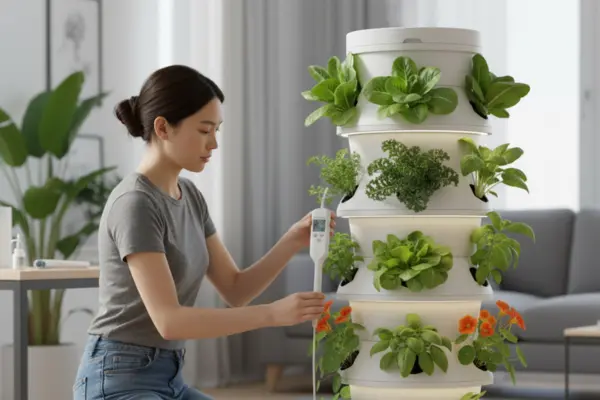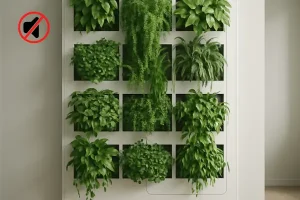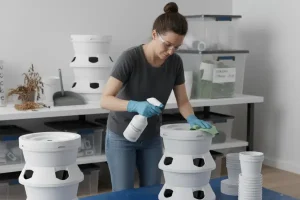If you’re growing vegetables, herbs, or flowers in a hydroponic vertical garden, one of the most important steps is monitoring water quality. Two key measurements are pH (how acidic or alkaline your water is) and EC (electrical conductivity, which shows nutrient levels).
Without accurate readings, plants may struggle to absorb nutrients, leading to yellowing leaves, poor growth, or reduced harvests. That’s why pH and EC meters are essential tools—and knowing how to install and calibrate them makes all the difference.
For vertical systems, you can choose simple handheld pens or install inline probes that read your reservoir continuously. Handhelds are affordable and great for quick checks; inline meters save time if you run pumps on a schedule.
Whichever you pick, keep fresh calibration solutions (pH 4.0, 7.0, and EC/ppm standards), rinse probes with clean water after use, and store pH probes in storage solution—not dry.
Place sensors where water is well mixed (near the pump return), and note that temperature affects readings—meters with automatic temperature compensation (ATC) are worth it. With a few good habits, your readings stay accurate and your plants stay happy.
Why pH and EC Matter
pH (potential hydrogen)
pH tells you how acidic or alkaline your solution is, and it directly affects how well roots can absorb each nutrient. Keep most hydroponic vertical gardens in the 5.5–6.5 range (sweet spot around 5.8–6.2). Outside this window, nutrients like iron, calcium, and phosphorus can “lock out,” so plants look hungry even when food is present.
Tips: test at least 2–3 times per week, especially after top-ups; adjust gradually with pH up/down; remember that fresh nutrients can shift pH—recheck 15–30 minutes after mixing.
EC (electrical conductivity)
EC measures the total dissolved salts in your water, giving a quick snapshot of nutrient strength. It helps you avoid overfeeding (leaf tip burn, salt buildup) and underfeeding (slow, pale growth). As a guide, aim for 1.2–2.0 mS/cm for leafy greens and 2.0–3.0 mS/cm for fruiting plants like tomatoes or peppers. Young seedlings prefer the low end; mature, heavy feeders can handle more.
Tips: track EC trends over time—if EC rises while water level drops, plants are drinking more water than nutrients (top up with plain water). If EC falls quickly, they’re feeding heavily (increase strength slightly at the next mix).
Step 1: Choosing the Right Meters
- Handheld meters: Affordable, portable, easy to use. Great for small vertical gardens.
- Continuous monitors: Stay installed in the reservoir for constant readings. Best for medium or automated systems.
- Smart sensors with app integration: Send real-time updates to your phone. Ideal for high-tech setups.
Step 2: Installing Your Meters
For pH meters:
- Place the probe into your reservoir or nutrient solution.
- If using continuously, make sure it’s mounted securely and not touching the sides.
- For handheld meters, simply dip when testing.
For EC meters:
- Submerge the probe in the water for a few seconds.
- Avoid bubbles or debris near the probe tip.
- Keep consistent depth for accurate readings.
Step 3: Calibrating Your Meters
Meters need calibration to stay accurate. Most kits come with calibration solutions.
- Calibrating a pH meter:
- Rinse probe with distilled water.
- Dip in calibration solution (usually pH 4.0 and 7.0).
- Adjust meter according to instructions.
- Rinse probe with distilled water.
- Calibrating an EC meter:
- Rinse probe.
- Dip into EC calibration solution (commonly 1.4 or 2.7 mS/cm).
- Adjust until reading matches the solution value.
- Rinse probe.
Repeat calibration every 2–4 weeks or whenever accuracy seems off.
Step 4: Using the Readings
- If pH is too high: Add a “pH down” solution (often phosphoric acid).
- If pH is too low: Add a “pH up” solution (often potassium hydroxide).
- If EC is too high: Dilute the solution with fresh water.
- If EC is too low: Add more nutrient solution gradually.
Quick Reference Table
| Measurement | Ideal Range | What to Do if Out of Range |
| pH | 5.5–6.5 | Use pH up or down solutions |
| EC (leafy greens) | 1.2–2.0 mS/cm | Add or dilute nutrients |
| EC (fruiting plants) | 2.0–3.0 mS/cm | Adjust nutrient strength |
Common Mistakes to Avoid
- Skipping calibration: Leads to inaccurate readings.
- Using tap water for calibration: Always use distilled water and calibration solution.
- Letting probes dry out: Keep pH meter probes moist (use storage solution).
- Testing only once in a while: Nutrient levels shift daily—check regularly.
FAQs
Q: Do I need both pH and EC meters?
Yes. pH ensures nutrient absorption, while EC confirms correct nutrient strength. Both are crucial for hydroponics.
Q: How often should I test my water?
At least every other day for hydroponic vertical gardens; daily is ideal.
Q: Can I use test strips instead of meters?
Strips are cheaper but less accurate. Meters give consistent, reliable results.
Q: How long do pH and EC meters last?
With care and proper calibration, 1–3 years on average.
Next Steps & Related Reading
To automate watering along with monitoring, read Best Drip-Irrigation Kits for Small-Scale Vertical Gardens.
For overall system care, check How to Sterilize & Store Equipment Between Growing Seasons.
Conclusion
Installing and calibrating pH and EC meters may seem technical, but it’s a simple routine that ensures healthy, productive plants. With accurate readings, you’ll avoid nutrient imbalances and keep your vertical garden thriving.
Will you start with a budget-friendly handheld meter, or invest in a continuous monitor for peace of mind?




